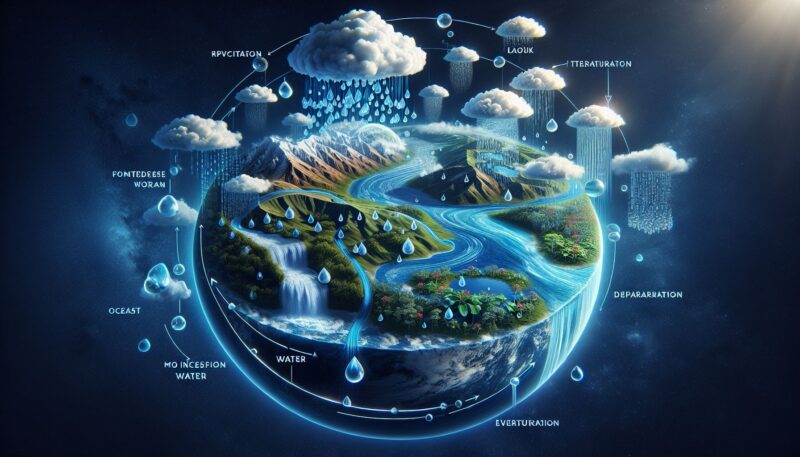The hydrologic cycle, also known as the water cycle, is a fundamental process that is relentless in its motion, circulating water throughout the Earth’s hydrosphere. It’s this continuous process that replenishes our water sources, shapes our landscapes, influences climate, and supports all forms of life. Understanding the hydrologic cycle is crucial for the practical management of water resources and for making informed decisions that affect our environment and society.
What is the Hydrologic Cycle?
In its simplest form, the hydrologic cycle describes the movement of water above, on, and below the surface of the Earth. This cycle is a closed system, meaning that the amount of water does not change but is rather redistributed in different forms: liquid, vapor, and ice. Driven by the energy from the sun and gravity, water is constantly cycling through various processes that include evaporation, transpiration, condensation, precipitation, infiltration, percolation, runoff, and storage in natural reservoirs like oceans, lakes, glaciers, and aquifers.
The Driving Forces Behind the Cycle
Solar Energy and Gravity
Solar energy is the prime mover of the hydrologic cycle. It supplies the heat necessary for evaporation, which is the process of turning liquid water into vapor. This vapor rises into the atmosphere, where it cools and condenses to form clouds. Gravity then takes over, pulling the condensed water particles down as precipitation—be it rain, snow, sleet, or hail.
The Processes
Evaporation and Transpiration
Evaporation occurs when water is heated and converted into vapor from bodies of water like rivers, lakes, and oceans. Transpiration is similar to evaporation but occurs in plants as they release water vapor from their leaves into the atmosphere – this collective process is sometimes referred to as evapotranspiration.
Condensation
Condensation is the process that turns water vapor into liquid droplets or ice crystals, forming clouds. This process is often observable as dew on plants or the outside of a cold glass on a hot day.
Precipitation
When these droplets or crystals become too heavy to stay airborne, they fall from clouds as precipitation, restoring water to the Earth’s surface.
Infiltration, Percolation, and Runoff
Water that reaches the ground can follow different paths. It may infiltrate (seep into the soil), percolating down to recharge groundwater supplies, or it may flow as surface runoff into rivers and lakes, eventually making its way to the oceans.
Groundwater Movement
Groundwater, which is stored in aquifers, moves slowly and can exit into streams, lakes, or into the ocean to become part of the baseflow contribution. This exit of water from the ground is known as discharge.
Interception
Before precipitation even reaches the ground, it might be temporarily intercepted by vegetation, buildings, or other structures. Some of this intercepted water evaporates back to the atmosphere while some contribute to the runoff and infiltration processes.
Why the Hydrologic Cycle is Important
The hydrologic cycle is essential for many reasons. It plays a key role in regulating the climate by transporting heat around the globe through water vapor. It’s also critical for the sustainability of ecosystems, supplying fresh water to maintain habitats and biodiversity.
Water for Human Use
Humans rely heavily on the hydrologic cycle for fresh water. The availability of water influences where we can live, grow our food, and develop our cities. It’s through this cycle that our primary water reservoirs are naturally refilled, and understanding it can help us manage water resources more effectively, especially in the face of climate change and increasing demands.
Weather and Climate
The water cycle also influences weather patterns and, consequently, climate conditions. For instance, regions downwind of large bodies of water tend to have higher precipitation because of the evaporation and transport of moisture from these surfaces.
Threats to the Hydrologic Cycle
Alterations to the hydrologic cycle can disrupt the delicate balance of ecosystems and lead to adverse effects on water availability. Human activities such as deforestation, urban development, and the emission of greenhouse gases affect the cycle’s dynamics.
Climate Change
Climate change, largely driven by human activity, alters the hydrologic cycle by changing precipitation patterns, increasing evaporation rates, and altering runoff patterns. This can result in more severe droughts or floods, affecting water availability and quality.
Pollution
Pollution from various sources can contaminate water at different points in the cycle. For example, water can become polluted from agricultural runoff containing pesticides and fertilizers, or from industrial wastes being improperly disposed of into waterways.
Land Use Changes
Deforestation and urbanization can lead to changes in infiltration and runoff. Forests naturally store and release water, but when trees are removed, less water is absorbed by the soil, increasing runoff and reducing groundwater recharge. Impervious surfaces in urban areas, such as roads and buildings, exacerbate this problem, leading to more runoff and potential flooding.
Preserving the Hydrologic Cycle
To protect and preserve the hydrologic cycle, several measures need to be taken, ranging from reducing greenhouse gas emissions to improving water management practices.
Sustainable Water Management
Sustainable water management includes practices like conserving water, protecting watersheds, managing urban runoff, and restoring wetlands that naturally store and filter water.
Pollution Control
Pollution control measures involve reducing the release of harmful chemicals into the environment and improving wastewater treatment processes to ensure that water returned to the cycle is clean.
Climate Change Mitigation
Mitigating climate change by reducing greenhouse gas emissions can help stabilize the hydrologic cycle by preventing extreme variations in weather patterns.
Conclusion
The hydrologic cycle is an extraordinary and complex system integral to life on Earth. Understanding its mechanisms and importance is essential for managing our water resources and ensuring a healthy planet for future generations. By taking steps to protect this vital cycle, we can ensure that the flow of water, so critical to all aspects of our planet, is preserved and remains in balance.
Sources
- “The Water Cycle | U.S. Geological Survey.” USGS, U.S. Geological Survey.
- “Hydrological cycle.” Encyclopedia Britannica, Encyclopedia Britannica, Inc.
